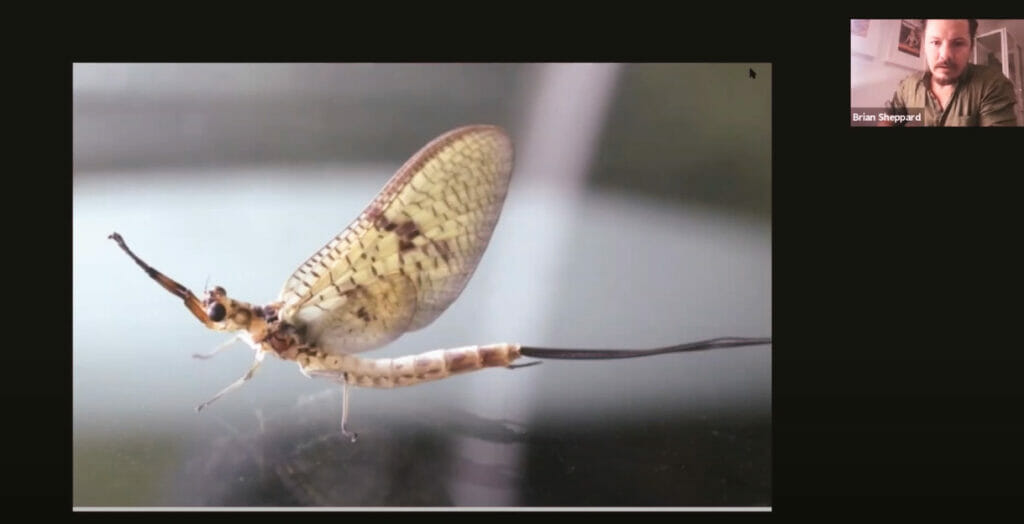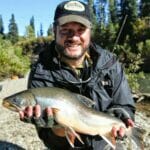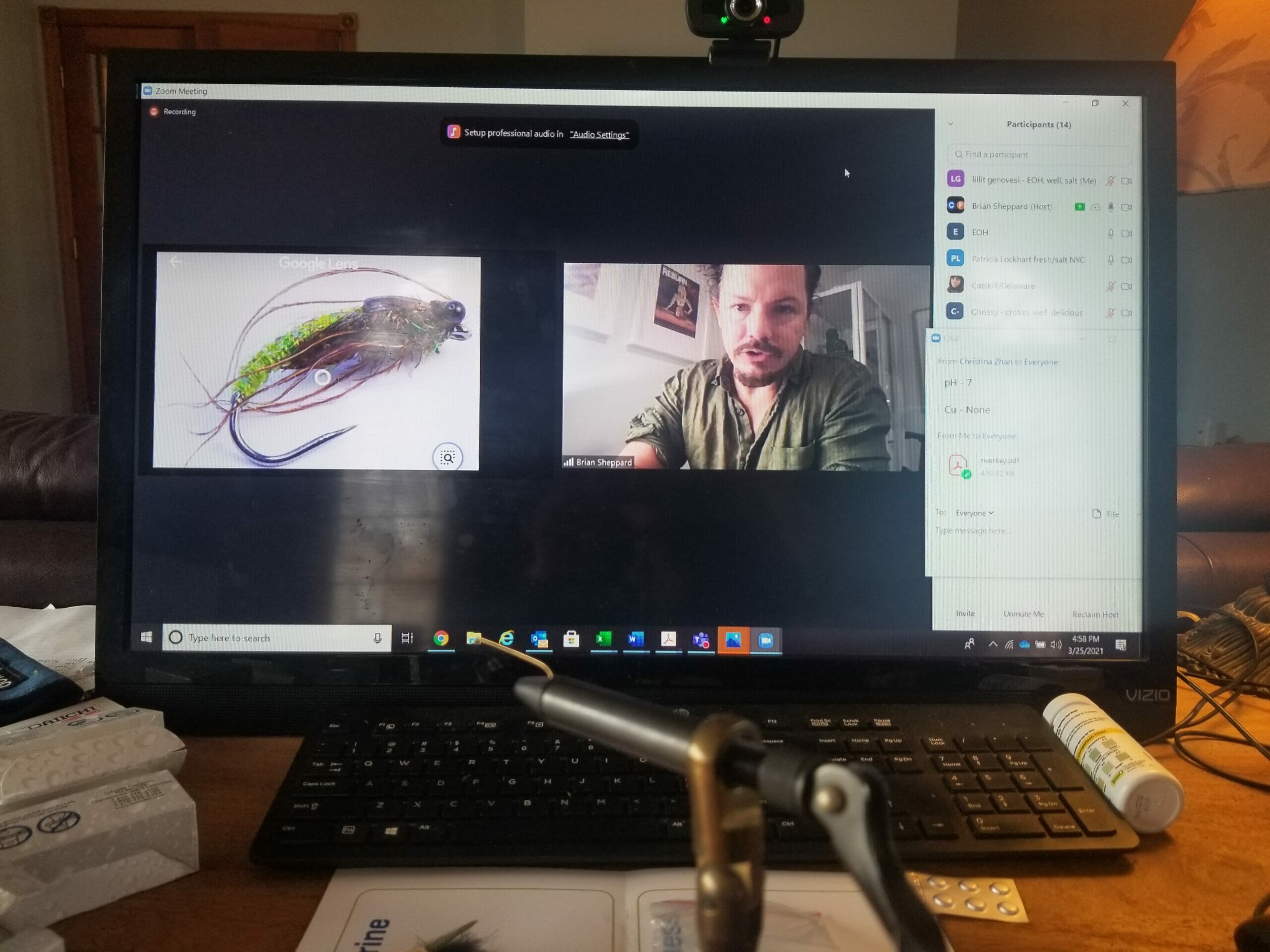Trout Unlimited’s TIC teachers learn fly tying and entomology from actor Brian Sheppard
Training sessions often get labeled as a boring, but required, means of qualifying to hold certain positions in society.
The teachers who help with Trout Unlimited’s Trout in the Classroom program have gone through enough rigmarole to last a lifetime. Lillit Genovesi, New York City and Watersheds Trout in the Classroom coordinator for TU, decided to make a recent TIC training fun for the teachers.
Instead of a training session dulled even further with Zoom fatigue, Genovesi called it a professional learning opportunity and sent participants a STEM-in-a-Box tool kit for a virtual tutorial like none other.
The night featured an entomology primer and fly-tying presentation from professional zombie killer Brian Sheppard of The Walking Dead. Thanks to the help of J Stockard Fly Fishing, participants received a fly-tying vise, tools and tying material and were able to tie a Wooly Bugger at home while watching Sheppard, who played Miles on the Walking Dead series, do the same.
Teachers learned about the TU Rivers App and how to conduct redd (spawning bed) counts from Trout Unlimited staffer Caroline Shafer. Robin Sanchez, education director of the New York City Department of Environmental Protection, led a virtual tour of New York City Water and Diane Corrigan, a teacher in the TIC program led a presentation on tapwater and water quality testing.
“We are grateful for the donation of supplies from J. Stockard that helped us to provide a hands-on virtual fly-tying workshop for our incredible TIC teachers and to Brian for leading this workshop and sharing his passion for the art,” Genovesi said. “We are looking forward to being able to provide a class set of vices and supplies to schools who want to lead this science and art experience for their students”.

The PLO was sponsored by grants from the Dorr Foundation and ConEdison. Other supplies were provided by the New York City TU Chapter and J. Stockard Fly Fishing.
Trout in the Classroom is a hands-on, STEM focused, environmental education program for students in grades P-12. Each fall, TIC schools receive trout eggs from the New York State Department of Environmental Conservation. Over the course of eight months, students learn to take care of their fish, monitor water chemistry in the tank, study the delicate life cycle of the trout, and grow to understand the importance of conserving and taking care of our watershed streams.
Each spring students and teachers journey to the city’s watershed streams to release their classroom-reared trout into the wild. TIC makes STEM learning meaningful, engaging and fun. In 2019, more than 250 New York schools were raising trout as part of the TIC program, engaging over 30,000 students.
Sheppard is more than a zombie slayer
You may be wondering how a zombie killer ended up leading a fly-tying presentation to teachers. Brian Sheppard is on the board of the New York City Trout Unlimited chapter and runs City Fly. He is a Fly Fishers International Bronze Fly Tyer and a professional tyer for Willowemoc Creek and Squimpish Flies.
Here’s a Q&A with actor and fishing guide.

How did you get involved in the Professional Learning Opportunity program?
I’ve been a member of the TU board for two seasons now. Over time Lilli has introduced opportunities for our chapter to be directly involved in TIC. The Covid pandemic actually freed me up so I could be available to help when needed. I helped this past fall with egg delivery and casting lessons and Lilli approached me to aid in tying and a chat about the fun world of trout and what they eat!
How did you get involved in fly fishing overall?
I learned to fly fish when I was 13. After years of being obsessed with “A River Runs Through It”, I received my first rod and reel. Friend and fly-fishing author Bob Romano took me to the Little Flatbrook for my first evening hatch and I was hooked. The following day he taught me to tie my first simple fly. Fast forward 20 years later and I found myself living in NYC and wanting to get back into the sport. Now it is part of my livelihood and passion in life!
Why do you feel programs like Lilli’s are important to the youth of NYC – and to the country?
I feel that kids run the risk of never seeing beyond their television screens and high rise buildings. If our youth never see what’s out there they will have trouble appreciating and conserving our natural resources. I was fortunate to have this opportunity firsthand and it changed my life. Every time I head out it changes something in me. I learn daily. I think Lilli’s program is fostering this process on an incredible scale. For these kids to help give life to trout and send them on their way is something they won’t soon forget. To walk in the woods and see what we have at stake is changing our future one child at a time. I believe it would be a complete loss to not provide these amazing hands-on opportunities. Personally, I see so much politicization and monetization of resources in such a disturbing and irreversible way. We love to consume without regard for the true cost. We may not be able to affect change on past generations, but we can and must shape the mentality and consciousness of future generations.
How is fly fishing like acting and vice versa?
Fly fishing and acting actually go hand in hand. Both require intense focus and lifelong study. Both require ease and empathy. I believe fly fishing greatly nurtures and expands the soul — that’s the one thing you must have to act. The competitive nature of the acting business can easily consume you and leave you stressed and worn down. Fly fishing and tying are my cure. I couldn’t do one without the other. It’s a perfect balance.
Brett Prettyman is the communications director for Trout Unlimited’s youth programs collectively known as Headwaters. He is based in Salt Lake City and volunteers in local schools as a Trout in the Classroom liaison.



